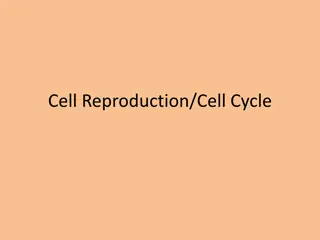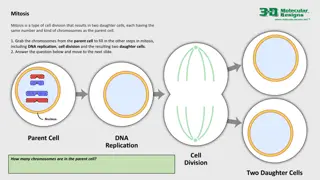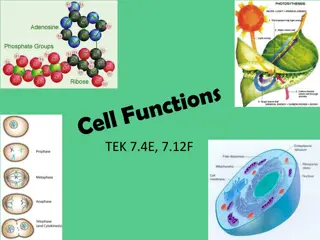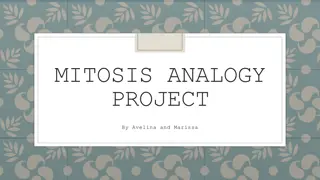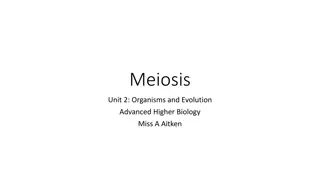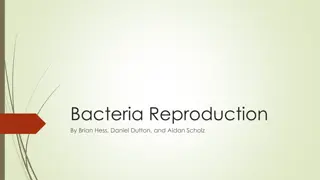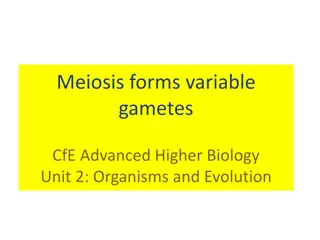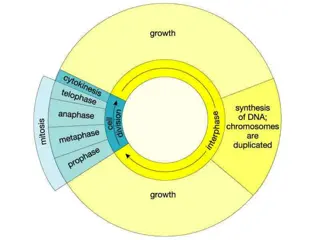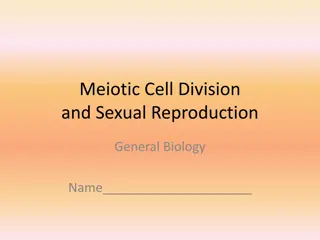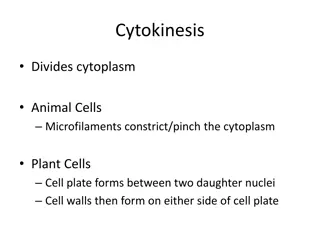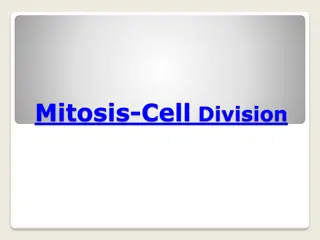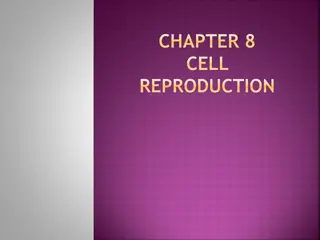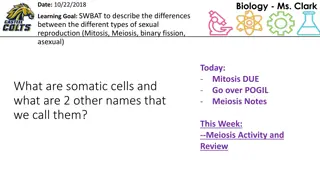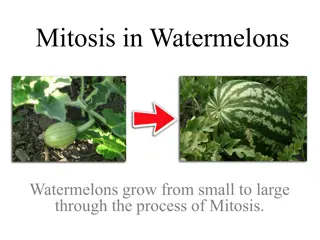Cell Division & Reproduction: Meiosis vs. Mitosis Explained
Explore the differences between meiosis and mitosis in cell division and reproduction. Learn about gametes, asexual reproduction, chromosomes, the cell cycle, and more. Understand how these processes contribute to growth, repair, and the creation of genetic diversity. Discover the intricacies of somatic cells, sex cells, and the vital roles they play in the formation of new life.
Download Presentation

Please find below an Image/Link to download the presentation.
The content on the website is provided AS IS for your information and personal use only. It may not be sold, licensed, or shared on other websites without obtaining consent from the author.If you encounter any issues during the download, it is possible that the publisher has removed the file from their server.
You are allowed to download the files provided on this website for personal or commercial use, subject to the condition that they are used lawfully. All files are the property of their respective owners.
The content on the website is provided AS IS for your information and personal use only. It may not be sold, licensed, or shared on other websites without obtaining consent from the author.
E N D
Presentation Transcript
Meiosis Making Gametes
Review Asexual Reproduction is also called _______________ Mitosis starts with one parent cell and ends up with __________________________________________ Genetically, the daughter cells are ________________ to the parent cell Making an identical copy of a cell is also called _______________ What type of cells in YOUR BODY divide by Mitosis? ________________ The scientific term for Body cells is ______________ These cells are considered 2n (diploid). What does that mean? _______________________________________
Review Contd How many Chromosomes should a normal human have? _____ If a human skin cell must divide to heal a wound, how many chromosomes would each of the daughter cells have? _____ If a human bone cell must divide because a baby is growing, how many chromosomes would each of the daughter cells have? _________ What are two reasons for Mitosis? __________ & ___________ Which organelle is in control of cell division? ___________ What happens when the nucleus loses control? __________
Mitosis Asexual Cell Reproduction Necessary for growth & repair Chromosomes in Somatic Cells are in pairs 2N (diploid) Two new daughter cells are identical copies of original parent cell Clones
Cell Cycle Sequence of phases in the life cycle of the cell Notice! Mitosis is only a SMALL part of the cell cycle! In what phase do cells spend most of their time? _____________ Mitosis & Cell Cyle
Sex Cells are Different Human beings have 46 chromosomes in every Somatic (Body) Cell This is a complete set But, if mom s egg cell has 46 And, if dad s sperm cell has 46 The Zygote (the fertilized egg cell) would have 92! Would THAT make a human?
Meiosis Cell division of reproductive cells (sex cells) Gametes or germ cells (sperm and egg) Produced in Gonads Each new cell is not exactly like the parent cell Allows for variation Important for the survival of our species!
Meiosis In each new daughter cell, the chromosomes are not in pairs NOT 2n (not diploid!) At the end of Meiosis, four daughter cells contain half of the original number of chromosomes (N) Each is unique! Not identical to the parent
Gametes (aka germ cell) Mature egg or sperm cell Produced in the Gonads Each gamete has half the original number of chromosomes 1N (haploid) HALF IS IMPORTANT!
Why is Half is Important? Meiosis makes unique sex cells! Half the number of chromosomes (haploid) is important for sexually reproducing organisms! N = The number of chromosomes in a gamete To create a new organism, two parents give half of their own chromosomes to make a baby with a complete set of chromosomes! Half from mom Half from dad N + N = 2N (Zygote!)
Sexual Reproduction Sexual Reproduction requires two parents Offspring have SOME traits inherited from each parent but not all! YOUR DNA is not identical to either parent It is a mix of genes from both parents Meiosis
Sexual Reproduction Fusion of two (N) gametes to produce a single zygote (2N) Introduces greater genetic variation, allows genetic recombination A VERY GOOD THING!
Chromosome Pairing Homologous pair Homologous means similar Each chromosome in the pair are Homologous to the other (carry genes for same trait) Only one pair differs - sex chromosomes X or Y
Different! Metaphase I in Meiosis Chromosomes form TETRADS (four together) Metaphase II in Meiosis Chromosomes line up in the middle and then a SECOND DIVISION happens! The two daughter cells are divided into four and each has HALF the chromosome number!
Independent assortment of homologous chromosomes POSSIBILITY 1 POSSIBILITY 2 Two equally probable arrangements of chromosomes at metaphase I Metaphase II Gametes Combination 4 Combination 2 Combination 1 Combination 3 Figure 8.16
Crossing over increases genetic variability The exchange of genes between two homologous chromosomes happens when in Tetrad formation
Tetrad Chaisma Centromere Figure 8.18A
SPERMATOGENESIS OOGENESIS spermatogonium oogonium egg spermatids polar bodies (will disintegrate)
Review Mitosis & Meiosis Both are forms of cell division Both involve replication Both involve disappearance of the nucleus, and nucleolus, nuclear membrane Both involve formation of spindle fibers


